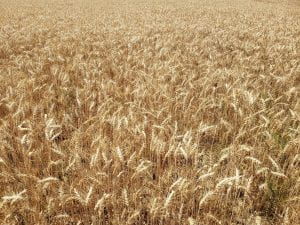Soybean Aphids are Building

I had a report and pictures over the weekend that soybean aphids were found over threshold and had to be sprayed. Some follow up revealed that the soybeans did not have a seed insecticide on them. I know we have not really had to deal with soybean aphids for many years now and many have forgotten to even scout for them. Neonicitinoid seed treatments such as Cruiser have been effective in giving us some early protection from aphids coming off buckthorn and starting the initial populations on soybeans. I checked some fields in Ontario County that were untreated and again found some large established aphid colonies and many of the plants were way over the 250 threshold per plant. Adult ladybug beetles were present, but I did not see any eggs or larvae yet. I also checked many treated soybean fields in the same area and could not find any aphids.
All soybean fields should be scouted but If you have soybeans without a seed insecticide, you should be scouting them ASAP to see if colonies have been started. I also saw many winged forms that will be flying from plant to plant and starting new colonies. Monitor weekly to see if aphid populations are not exceeding the 250/plant threshold. Hopefully, natural enemies can find them early and keep them in check. If not, an insecticide is warranted to protect yield.
Are you Ready for Wheat Harvest?

Wheat harvest is still 7 to 10 days away but are you ready to go? All I can think about is how much of our wheat crop pre-sprouted last year. Be prepared to take wheat out at 18-20% moisture if you have the capacity to dry it. With wheat at all time highs, we need the best quality we can get. I have also had questions about protecting grain quality in the bin. Tempo Ultra SC can be sprayed as an empty bin treatment. Storcide II can be directly applied to the grain as it is going into the bin. Our wheat is looking good for what it has been through. I do not think yields will be as good as last year but hoping the quality and price make up for it.
Nitrogen Sidedress
In some areas of western New York, we are dry. Current weather forecasts show these dry conditions are going to persist for the next several days. A few of you may be wondering whether to make changes to your corn sidedress N applications based on current, and forecasted, weather. Here are a few things to keep in mind:
Urea or urea ammonium nitrate (UAN) are the most common sidedress N sources and can be lost through volatilization. Urease inhibitors should be used to prevent any decomposition of urea and vitalization of ammonia. A urease inhibitor is likely unnecessary if UAN is knifed in and the soil is closed behind application. Delaying your sidedress application depends of the height of the crop and application equipment available. Pre-sidedress nitrate soil test (PSNT) are always a good in season management tool you can use to determine your N sidedress needs. A recent N sidedress study conducted by Dr. Quirine Ketterings found that if additional N is required beyond your starter for optimal yield, it is best to sidedress earlier (V4-V6) rather than later in the season. It also indicated that a later sidedress application (V8-V10) still help improve yields versus no sidedress N application. Click here to read more Sunoj et al. (2021)
Last Day to Apply Dicamba Products on Dicamba Resistant Soybeans
Today, June 30, is the last legal day to apply XtendiMax, Engenia, and Tavium on dicamba resistant soybeans. This is a true cut-off day for application of these dicamba products and it does not matter when the soybeans were planted.
I saw my first flowers in some soybean fields this week. This is the R1 stage. This is a critical stage of application of the other traited post-emergence products.
Glyphosate products can be applied up to R2 which is the full flower stage.
Glufosinate (LibertyLink): Applied up to first bloom (R1 stage). Do not apply if plants have reached R2 (full flower). This is a short 4-day period between R1 and R2.
Enlist (E3), (Glyphosate, Glufosinate & 2,4,-D): Do not apply beyond R2 (full flower).


